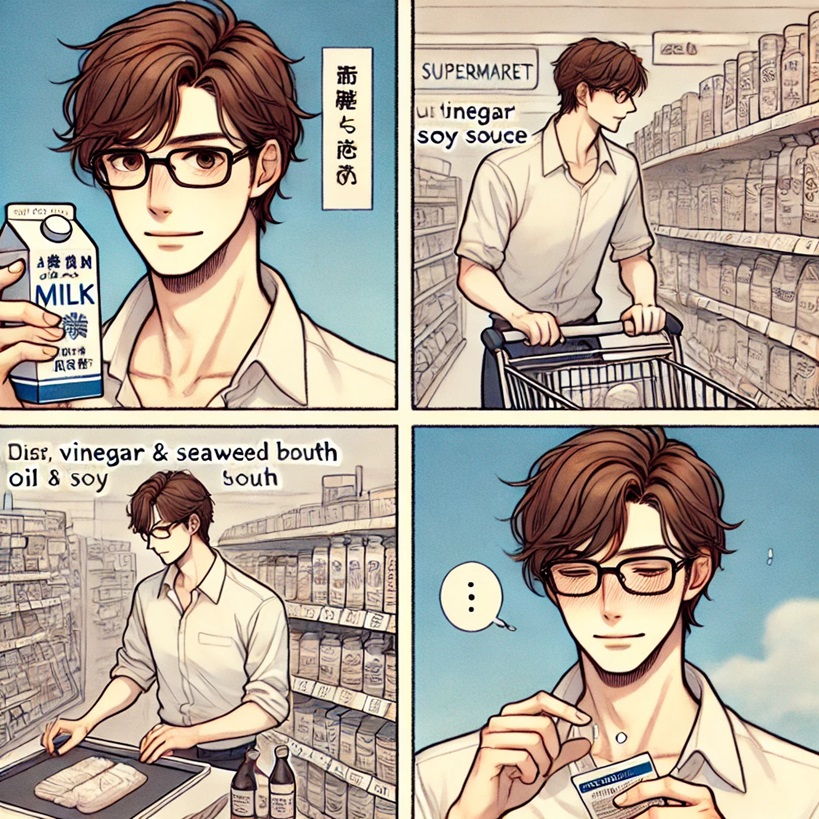My first shopping trip to Japan - language barriers and surprises
My first shopping trip to Japan was a challenge: forgotten phrases, unclear packaging and a bit of confusion. But I managed it in the end!
Vincent
2/2/20253 min read


My first shopping trip in Japan - Lost phrases and puzzling foods
I've just come from my first shopping trip in Japan and it was confusing, but I still managed. I was already expecting to have problems with the language, so I tried to memorise phrases for the supermarket beforehand.
The forgotten phrases - suddenly speechless
Of course, I picked out some phrases that I wanted to say for the respective points. I wanted to say the following phrases, depending on how I needed them:
In case I need a bag: Please a bag - Fukuro o kudasai.
If I don't need a bag: I don't need a bag - Fukuro wa irimasen.
If I want to pay by card: By card, please - Kaado de onegai shimasu.
If I want to pay in cash: With cash, please - Genkin de onegai shimasu.
And finally the thank you: Thank you (when leaving) - Arigatou gozaimashita.
Well, that was the little preparation I had planned, plus a list of foods with Japanese spelling.
The food in Japanese
But then at the supermarket, nothing was labelled the same as on my list. Milk wasn't labelled milk, but of course some other things, like probably ‘organic’, ‘good husbandry’ etc. I realised that it was milk, but there are different fat percentages etc. I then simply took a packet with a cow on it and now, when translating with my mobile phone with WLAN (I don't have mobile data yet), I realise that it was correct.
There were of course simple foods like vegetables and meat, but when it came to the spices and cooking oil, I was completely lost.
Fortunately, salt and pepper were labelled in English, but I'm sure these versions were always a bit more expensive than the others. But at least I could be sure that I was buying the right things. I wasn't sure about the oil and soya sauce. And when I got home, I found out through my translator that I'd bought vinegar and seaweed broth by mistake... I'll probably have to go again, preferably with sentences read aloud and a helper.
And then I was at the checkout.
And what did I come up with? Nothing at first. The cashier asked me something about fukuro (bag), which I could at least understand, and then I said ‘Yes, please... Hai (Japanese for yes)’. I was embarrassed that I couldn't even say yes or please directly with all my preparation. Well, and then at least I managed to get out ‘Genkin de onegai shimasu’ (With cash, please) when she had settled everything, to which she also replied with ‘Hai’ and a nod. When I had paid and received the change, I wanted to say thank you, but my brain got in the way. I said something along those lines, but not the right thank you, that much I remember. And then I packed my things into a bag and had to weave my way through two people. They didn't see me and I said ‘Sumimasen’ (sorry) and went through. Normally you say thank you for something like that in Japanese, but I couldn't think of anything. As a German, you probably think that's fine, but in Japan you have to be more polite.
Lift
Once back in the building, I met a Japanese man in front of the lift for the first time. He bowed to me and I did the same, as much as I could with a heavy bag. Then we both got into the lift and wanted to press the button, but let him in first. When I wanted to press the button, he asked me something short, but I understood ‘nan’ (what, which) and said ‘Juuni’ (12) after a short visible consideration. Then he pressed it and I thanked him politely. When we said goodbye, he half-turned to me and bowed, and I did the same.
Conclusion
There were a few moments of uncertainty, and perhaps I should have prepared myself a little better. And in hindsight, some of the encounters were unpleasant, but now I've learnt something new. I'm particularly annoyed that I bought vinegar and seaweed broth now, as I stood in front of the shelf for a really long time. Nevertheless, the purchase was 90% successful and therefore I should probably be 90% happy.
Next time, I will definitely google the products in Japanese in advance and then take pictures of them with me so that I can compare them with the food. I will also be a little less shy about asking the sellers. Instead, I will pick out ‘Where can I find ...’ - questions that I can use.
How did I survive my trip here with my poor Japanese? You can find out more here: Four flights to Japan
